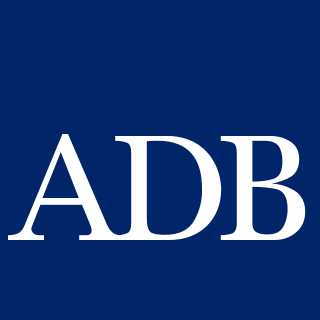
The Asian Development Bank (ADB) is a regional development bank established on 19 December 1966, which is headquartered in the Ortigas Center located in the city of Mandaluyong, Metro Manila, Philippines. The company also maintains 31 field offices around the world to promote social and economic development in Asia. The bank admits the members of the United Nations Economic and Social Commission for Asia and the Pacific and non-regional developed countries. From 31 members at its establishment, ADB now has 68 members.

Banking in the United States began by the 1780s along with the country's founding and has developed into highly influential and complex system of banking and financial services. Anchored by New York City and Wall Street, it is centered on various financial services namely private banking, asset management, and deposit security.
In banking, the term national bank carries several meanings:

ATB Financial is a financial institution and Crown corporation wholly owned by the province of Alberta. Originally established as Alberta Treasury Branches in 1938, ATB Financial operates only in Alberta and provides financial services to over 800,000 Alberta residents and businesses. Headquartered in Edmonton, ATB Financial has over 5000 team members.

National Bank of Pakistan (NBP) is a Pakistani government-owned multinational commercial bank which is a subsidiary of State Bank of Pakistan. It is headquartered in Karachi, Pakistan. As of September 2020, it has 1,511 branches across Pakistan with assets of approximately USD 20.2 billion.
The IDBI Bank Limited is a subsidiary of Life Insurance Corporation (LIC) providing financial and banking services. It was established in 1964 as Industrial Development Bank of India, a development finance institution, which provided financial services to industrial sector. In 2005, the institution was merged with its commercial division, IDBI Bank, forming the present-day banking entity and was categorised as "other public sector banks" category. Later in March 2019, RBI recategorised it as a private bank. Many national institutes find their roots in IDBI like SIDBI, India Exim Bank, National Stock Exchange of India and National Securities Depository Limited.

The African Development Bank Group or Banque Africaine de Développement (BAD) is a multilateral development finance institution headquartered in Abidjan, Ivory Coast, since September 2014. The AfDB is a financial provider to African governments and private companies investing in the regional member countries (RMC).
Aga Khan Agency for Microfinance (AKAM) is a microfinancing agency of the Aga Khan Development Network.

Afghanistan International Bank (AIB) is the largest bank in Afghanistan and the only Afghan bank with international transfer to all countries, with its head office in Kabul. The bank has thirty seven branch offices in the major cities of the country. AIB has international shareholders, two Afghan business groups, one Afghan/American business group. It opened in 2004.

The Bank of Mozambique is the central bank of Mozambique. The bank does not function as a commercial bank, and has the responsibility of governing the monetary policies of the country. The president of the Republic appoints the governor. The bank is situated in the capital, Maputo, and has two branches, one in Beira and one in Nampula. The Bank of Mozambique is active in developing financial inclusion policy and is a member of the Alliance for Financial Inclusion.
New Kabul Bank is a bank in Afghanistan that has its main branch in the capital city of Kabul. It was established in 2004 as the Kabul Bank, the first private bank in Afghanistan. After corruption and scandals it was re-established in 2011 as the New Kabul Bank.
China's banking sector had CN¥319.7 trillion in assets at the end of 2020. The "big four/five" state-owned commercial banks are the Bank of China, the China Construction Bank, the Industrial and Commercial Bank of China, and the Agricultural Bank of China, all of which are among the largest banks in the world as of 2018. The Bank of Communications is sometimes included. Other notable big and also the largest banks in the world are China Merchants Bank and Ping An Bank.
The history of banking in China includes the business of dealing with money and credit transactions in China.
Rawbank is a commercial bank of the Democratic Republic of the Congo. The bank was created on 2 May 2002, having received a Congolese banking license, to operate as a commercial bank by the end of 2001. The bank opened with 10 employees. Since March 2020 the CEO of the bank is Mustafa Rawji and the Chairman of the bank is Mazhar Rawji. Rawbank is the largest bank operating in the Democratic Republic of the Congo with a balance sheet of $2.1 billion at end of financial year 2019. The bank had a staff of more than 1,800, as at 31 December 2019.
Following the Iranian Revolution, Iran's banking system was transformed to be run on an Islamic interest-free basis. As of 2010 there were seven large government-run commercial banks. As of March 2014, Iran's banking assets made up over a third of the estimated total of Islamic banking assets globally. They totaled 17,344 trillion rials, or US$523 billion at the free market exchange rate, using central bank data, according to Reuters.
Bangladesh is a developing country with an impoverished banking system, particularly in terms of the services and customer care provided by the government run banks. In recent times, private banks are trying to imitate the banking structure of the more developed countries, but this attempt is often foiled by inexpert or politically motivated government policies executed by the central bank of Bangladesh, Bangladesh Bank. The outcome is a banking system fostering corruption and illegal monetary activities/laundering etc. by the politically powerful and criminals, while at the same time making the attainment of services or the performance of international transactions difficult for the ordinary citizens, students studying abroad or through distance learning, general customers etc.
Before Uganda's independence in 1962, the main banks in Uganda were Barclays ; Grindlays, Standard Bank and the Bank of Baroda from India. The currency was issued by the East African Currency Board, a London-based body. In 1966, the Bank of Uganda (BoU), which controlled the issue of currency and managed foreign exchange reserves, became the central bank and national banking regulator. The government-owned Uganda Commercial Bank and the Uganda Development Bank were launched in the 1960s. The Uganda Development bank was a state-owned development finance institution, which channeled loans from international sources into Ugandan enterprises and administered most of the development loans made to Uganda.

Water supply and sanitation in Mozambique is characterized by low levels of access to an at least basic water source, low levels of access to at least basic sanitation and mostly poor service quality. In 2007 the government has defined a strategy for water supply and sanitation in rural areas, where 62% of the population lives. In urban areas, water is supplied by informal small-scale providers and by formal providers.
Banco Macro is the second largest domestically-owned private bank in Argentina, and the sixth-largest by deposits and lending.

Banking in Turkey is an important aspect of the financial system Turkey's dynamic economy. Banks handle the majority of money and capital market transactions and activity. Commercial banks make up the majority of Turkey's financial sector, accounting for 91 percent of overall financial sector assets as of 2020.









